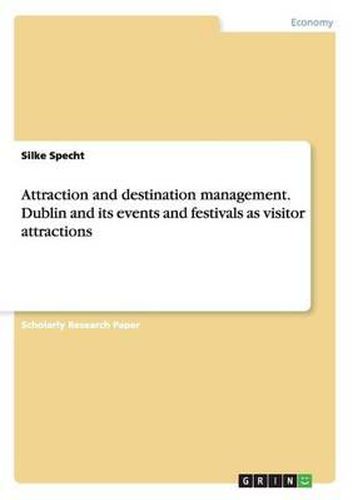Readings Newsletter
Become a Readings Member to make your shopping experience even easier.
Sign in or sign up for free!
You’re not far away from qualifying for FREE standard shipping within Australia
You’ve qualified for FREE standard shipping within Australia
The cart is loading…






Research Paper (undergraduate) from the year 2009 in the subject Tourism, grade: 1,7, University of Southern Denmark, language: English, abstract: When thinking of Ireland many people might see an image of the ‘green island’ or the ‘smaller brother’ of the UK, but especially Dublin has much more to offer for tourists, who value the city’s attractions and specialities highly. Dublin is one of Europe’s oldest capitals, encompassing not only historical sites and governmental institutions, but also a magnificent physical setting with the Dublin Bay, Wicklow Mountains and the River Liffey as natural attractions, as well as diverse cultural sites and institutions like museums and art galleries, St. Audoen’s Church and Ireland’s largest church, the Christ Church Cathedral, and Dublin Castle as one of the most important historic sites (Ireland Funds - Destination Dublin 2008). Today there are just over 1.1 million people living in Dublin County, while the city is able to attract about four times as many visitors each year made up from a wide cross-section of market segments. Visitors are attracted by the elegance of the city, its atmosphere and nightlife, and the ‘craic’, that make Dublin special. Beside numerous visitor attractions tourists come to visit Grafton Street, the commercial and social centre of Dublin, see the stylish Georgian streets and the graceful terraced houses with their central gardens, or relax in one of the large parks or botanical gardens (Ireland Funds - Destination Dublin 2008). To keep its position as a successful tourism destination Dublin has to develop visitor attractions that can meet the needs of the varying tourist segments coming to the city. Therefore the city created a wide attraction landscape ranging from traditional entertainment over museums and heritage centres, and historic sites and buildings, to parks and gardens and different wildlife attractions. Dublin provides numerous arts venues, traditional cafes and restaurants, as well
$9.00 standard shipping within Australia
FREE standard shipping within Australia for orders over $100.00
Express & International shipping calculated at checkout
Research Paper (undergraduate) from the year 2009 in the subject Tourism, grade: 1,7, University of Southern Denmark, language: English, abstract: When thinking of Ireland many people might see an image of the ‘green island’ or the ‘smaller brother’ of the UK, but especially Dublin has much more to offer for tourists, who value the city’s attractions and specialities highly. Dublin is one of Europe’s oldest capitals, encompassing not only historical sites and governmental institutions, but also a magnificent physical setting with the Dublin Bay, Wicklow Mountains and the River Liffey as natural attractions, as well as diverse cultural sites and institutions like museums and art galleries, St. Audoen’s Church and Ireland’s largest church, the Christ Church Cathedral, and Dublin Castle as one of the most important historic sites (Ireland Funds - Destination Dublin 2008). Today there are just over 1.1 million people living in Dublin County, while the city is able to attract about four times as many visitors each year made up from a wide cross-section of market segments. Visitors are attracted by the elegance of the city, its atmosphere and nightlife, and the ‘craic’, that make Dublin special. Beside numerous visitor attractions tourists come to visit Grafton Street, the commercial and social centre of Dublin, see the stylish Georgian streets and the graceful terraced houses with their central gardens, or relax in one of the large parks or botanical gardens (Ireland Funds - Destination Dublin 2008). To keep its position as a successful tourism destination Dublin has to develop visitor attractions that can meet the needs of the varying tourist segments coming to the city. Therefore the city created a wide attraction landscape ranging from traditional entertainment over museums and heritage centres, and historic sites and buildings, to parks and gardens and different wildlife attractions. Dublin provides numerous arts venues, traditional cafes and restaurants, as well